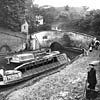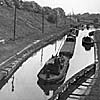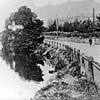 |
|
Coal transport / Canal As the road system gradually became slow and costly, the Grand Trunk Canal (later called Trent and Mersey Canal) system was proposed by James Brindley in 1758. Josiah Wedgewood cut the first sod at Browhills Tunstall (now bridge 129) in 1766. It became the main artery for local industries’ transport. The canal system was a direct and easy method of carrying larger quantities of coal, with a 50% reduction in costs. A major feature of this canal is The Harecastle ("legging") Tunnel. It took 11 years to complete (1766-1777) with a total length of 2,880yds. Men called ‘leggers’ lay on their backs on top of the cargo and pushed against the roof and sides of the tunnel with their legs to propel the boat along. Hence the name – ‘legging’ tunnel. A new tunnel parallel to Brindley’s, built by Thomas Telford and taking three years to build was opened in 1827. It was wider and was to include a towpath in its 14 ft span. This tunnel is still in use today. Click the image or highlighted words to see a larger version of the photograph and its description. It may take a while to download. |
|



